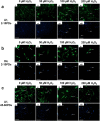Differential SOD2 and GSTZ1 profiles contribute to contrasting dental pulp stem cell susceptibilities to oxidative damage and premature senescence
- PMID: 33596998
- PMCID: PMC7890809
- DOI: 10.1186/s13287-021-02209-9
Differential SOD2 and GSTZ1 profiles contribute to contrasting dental pulp stem cell susceptibilities to oxidative damage and premature senescence
Abstract
Background: Dental pulp stem cells (DPSCs) are increasingly being advocated as viable cell sources for regenerative medicine-based therapies. However, significant heterogeneity in DPSC expansion and multi-potency capabilities are well-established, attributed to contrasting telomere profiles and susceptibilities to replicative senescence. As DPSCs possess negligible human telomerase (hTERT) expression, we examined whether intrinsic differences in the susceptibilities of DPSC sub-populations to oxidative stress-induced biomolecular damage and premature senescence further contributed to this heterogeneity, via differential enzymic antioxidant capabilities between DPSCs.
Methods: DPSCs were isolated from human third molars by differential fibronectin adhesion, and positive mesenchymal (CD73/CD90/CD105) and negative hematopoietic (CD45) stem cell marker expression confirmed. Isolated sub-populations were expanded in H2O2 (0-200 μM) and established as high or low proliferative DPSCs, based on population doublings (PDs) and senescence (telomere lengths, SA-β-galactosidase, p53/p16INK4a/p21waf1/hTERT) marker detection. The impact of DPSC expansion on mesenchymal, embryonic, and neural crest marker expression was assessed, as were the susceptibilities of high and low proliferative DPSCs to oxidative DNA and protein damage by immunocytochemistry. Expression profiles for superoxide dismutases (SODs), catalase, and glutathione-related antioxidants were further compared between DPSC sub-populations by qRT-PCR, Western blotting and activity assays.
Results: High proliferative DPSCs underwent > 80PDs in culture and resisted H2O2-induced senescence (50-76PDs). In contrast, low proliferative sub-populations exhibited accelerated senescence (4-32PDs), even in untreated controls (11-34PDs). While telomere lengths were largely unaffected, certain stem cell marker expression declined with H2O2 treatment and expansion. Elevated senescence susceptibilities in low proliferative DPSC (2-10PDs) were accompanied by increased oxidative damage, absent in high proliferative DPSCs until 45-60PDs. Increased SOD2/glutathione S-transferase ζ1 (GSTZ1) expression and SOD activities were identified in high proliferative DPSCs (10-25PDs), which declined during expansion. Low proliferative DPSCs (2-10PDs) exhibited inferior SOD, catalase and glutathione-related antioxidant expression/activities.
Conclusions: Significant variations exist in the susceptibilities of DPSC sub-populations to oxidative damage and premature senescence, contributed to by differential SOD2 and GSTZ1 profiles which maintain senescence-resistance/stemness properties in high proliferative DPSCs. Identification of superior antioxidant properties in high proliferative DPSCs enhances our understanding of DPSC biology and senescence, which may be exploited for selective sub-population screening/isolation from dental pulp tissues for regenerative medicine-based applications.
Keywords: Dental pulp stem cells; GSTZ1; Heterogeneity; Oxidative damage; Oxidative stress; Premature senescence; SOD2.
Conflict of interest statement
The authors declare that they have no competing interests.
Figures












Similar articles
-
Variation in human dental pulp stem cell ageing profiles reflect contrasting proliferative and regenerative capabilities.BMC Cell Biol. 2017 Feb 2;18(1):12. doi: 10.1186/s12860-017-0128-x. BMC Cell Biol. 2017. PMID: 28148303 Free PMC article.
-
Pleiotrophin Prevents H2O2-Induced Senescence of Dental Pulp Stem Cells.J Oral Rehabil. 2025 Mar;52(3):391-400. doi: 10.1111/joor.13918. Epub 2024 Dec 12. J Oral Rehabil. 2025. PMID: 39668573
-
Evaluation of Dental Pulp Stem Cell Heterogeneity and Behaviour in 3D Type I Collagen Gels.Biomed Res Int. 2020 Sep 10;2020:3034727. doi: 10.1155/2020/3034727. eCollection 2020. Biomed Res Int. 2020. PMID: 32964026 Free PMC article.
-
Senescence of dental pulp stem cells: phenotypes, underlying mechanisms and regulatory molecules.Hum Cell. 2025 Jul 11;38(5):127. doi: 10.1007/s13577-025-01259-y. Hum Cell. 2025. PMID: 40646329 Review.
-
Determinants of Dental Pulp Stem Cell Heterogeneity.J Endod. 2022 Oct;48(10):1232-1240. doi: 10.1016/j.joen.2022.06.013. Epub 2022 Jul 7. J Endod. 2022. PMID: 35809811 Review.
Cited by
-
A novel hypoxic lncRNA, HRL-SC, promotes the proliferation and migration of human dental pulp stem cells through the PI3K/AKT signaling pathway.Stem Cell Res Ther. 2022 Jun 28;13(1):286. doi: 10.1186/s13287-022-02970-5. Stem Cell Res Ther. 2022. PMID: 35765088 Free PMC article.
-
Identification of a Novel Target Implicated in Chronic Obstructive Sleep Apnea-Related Atrial Fibrillation by Integrative Analysis of Transcriptome and Proteome.J Inflamm Res. 2023 Nov 29;16:5677-5695. doi: 10.2147/JIR.S438701. eCollection 2023. J Inflamm Res. 2023. PMID: 38050561 Free PMC article.
-
The Wisdom in Teeth: Neuronal Differentiation of Dental Pulp Cells.Cell Reprogram. 2023 Feb;25(1):32-44. doi: 10.1089/cell.2022.0102. Epub 2023 Jan 31. Cell Reprogram. 2023. PMID: 36719998 Free PMC article. Review.
-
Delivery of dental pulp stem cells by an injectable ROS-responsive hydrogel promotes temporomandibular joint cartilage repair via enhancing anti-apoptosis and regulating microenvironment.J Tissue Eng. 2024 Jun 22;15:20417314241260436. doi: 10.1177/20417314241260436. eCollection 2024 Jan-Dec. J Tissue Eng. 2024. PMID: 38911101 Free PMC article.
-
Characterization of Fibronectin-Adherent, Non-Fibronectin-Adherent, and Explant-Derived Human Dental Pulp Stem Cell Populations.Dent J (Basel). 2025 Apr 2;13(4):159. doi: 10.3390/dj13040159. Dent J (Basel). 2025. PMID: 40277489 Free PMC article.
References
Publication types
MeSH terms
Substances
LinkOut - more resources
Full Text Sources
Other Literature Sources
Research Materials
Miscellaneous

